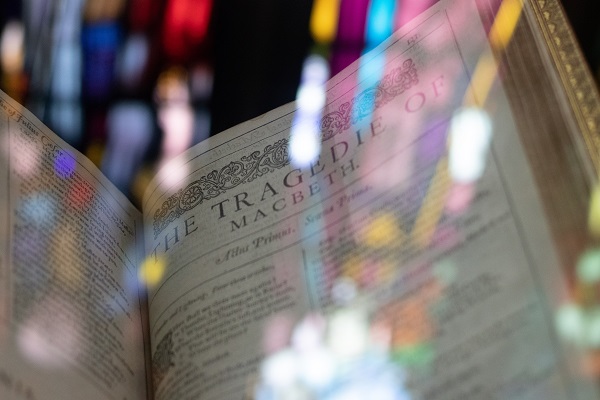Structure is the framework of a story. Understanding structure can help you, as a writer, develop those stories that aren’t quite hitting the mark yet.
We are used to act-based structure an audience, as we are better able to absorb and perceive stories when they consist of clear sections – e.g. the beginning, middle and end.
The three-act structure is the basic structure for many stories, and is the one most commonly used in films, books, and even jokes.
A five-act structure is a refinement of this. It can help writers handle a more complex story and give them greater control over the shape of their book, while still hitting the points readers expect from a story.
A quick history of structure
The earliest surviving work of dramatic and literary theory is Aristotle’s Poetics, in which he describes the structure of drama as the shape of a triangle.
This was called the Rhetorical Triangle, and it’s where the three-act structure we know today comes from.
When complicated stories with more nuanced plots became popular, the German playwright and novelist Gustav Freytag wrote a book called Die Technik des Dramas (Technique of the Drama) in 1863.
In this book, he described the five-act structure and changed Aristotle’s triangle into the diagram that we now call Freytag’s pyramid.
This is fairly similar to the three-act structure in its shape, but with a few key differences.
There more points that need to be hit, and the climax is no longer in the last act, but stays in Act 3; it isn’t meant to be the most dramatic part, but instead a change of direction for the story.
John Yorke’s book Into the Woods shows how a five-act structure can also be used to explore the change and growth of a character, and how this type of structure can work in stories of any genre.
So, how do you write a story with a five-act structure?
Whether you are a planner, a pantser or a combination of the two (a plantser), you can make sure your story flows the way it needs to by following a five-act structure.
To help you do this, we’ll go over each individual act and explore its purpose in terms of plot development as well as character growth.
We’ll look at a few examples from television (Grey’s Anatomy), film (The Godfather), and of course, the most famous use of the five-act structure – some of Shakespeare’s plays.
Act 1: Introduction
This act is for setting up your story. Introduce your readers to the characters, the world, and any important backstory that they may need.
This act isn’t the easiest one to write. You have a lot to do in not much time, and you have to ensure you entice your audience to carry on reading.
During this act, you need to set up the exposition and introduce the characters, the time and the place. At this point, your protagonist needs to either have a lack of knowledge or a clear flaw that they are to overcome.
This is also the part where you set up the rest of your story and any future conflict. What you set up here needs to be triggered throughout the story.

Like a three-act structure, the first act of a five-act structure needs to include the inciting incident.
You need to create a problem for your protagonist. It doesn’t need to be huge and dramatic; every story has a different conflict, and the way you introduce it can be loud and explosive or quiet and internal.
Let’s look at the pilot episode of Grey’s Anatomy. In Act 1, our main character, Meredith, meets Derek, the man she drunkenly slept with the night before.
They have a brief and entertaining exchange that not only introduces our leads, but tells us a few things:
- Meredith lives in her mother’s house;
- Her mother isn’t dead, and yet she’s not there;
- Meredith is about to have her first day in a new job.
This all happens within the first three minutes.
As the act progresses, we are introduced to the setting, Seattle Grace Hospital, as well as more characters – the hospital’s surgeons and the main patients for the episode.
At the end of the act/episode is the inciting incident, when Meredith realises that Derek also works at the hospital – and not only that, but he’s her boss as well.
This is not only the inciting incident for the episode, but for the show’s first season as a whole, as their romance is the main source of conflict for the season.
In a short span of time, this first act has set up the conflicts of the medical patients as well as Meredith and Derek’s relationship.
Note: Act 1 should generally only take up about 10% of the overall story.
Act 2: Rising Action
The second act continues the flow of the story by stepping up the conflict for your characters. Things will most likely be getting worse for them, and each situation needs to escalate the situation.
For your protagonist, this is the act where they leave their familiar world; they are embarking on a new adventure and leaving everything they know behind.
Depending on your story and genre, this can be more of an internal change rather than physical – but either way, your protagonist must start experiencing something different to what they are used to.
In tragedies and dramas, Act 2 is where things are going well for the protagonist; they will be getting something that they want.
The build-up of conflict will most likely come from outside characters while the lead celebrates things going the way that they wish.
In comedies, romantic or otherwise, Act 2 introduces situations that make things worse for the protagonist. They struggle through conflicts, making it seem like the ending we expect won’t happen.
The romantic interests will be further away than ever from coming together, and things will only get worse before they can get better.
As you’re developing your plot and characters in this act, you also need to expand your world.
Send your protagonist to different locations. Explain more of the lore and background. Introduce more characters. At the end of this act, the audience should know all of the main players.

As mentioned above, the genre of your story can change the way this act plays out. As an example, let’s compare two of Shakespeare’s plays, the tragedy Romeo and Juliet and the comedy Much Ado About Nothing.
In Romeo and Juliet‘s second act, things are going pretty well for the two lovestruck teenagers. They meet, have their moment on the balcony, and fall in love.
The conflict in this situation comes from the way they must hide their love. But there is a sense of hope (and naivety), as they seem to believe that they can get married and live happily ever after.
However, all of this is leading towards the climax in Act 3, when Tybalt dies and everything turns on its head for the couple.
In Much Ado About Nothing, Beatrice and Benedick are at the peak of their petty arguments, with very little love developing between them.
Don John is also setting in motion a plan to destroy Hero and Claudio’s relationship and ruin Hero’s reputation.
Note: This act is one of the longest, encompassing around 35–45% of the story.
Act 3: Climax
As in a three-act story, the third act in a five-act structure also includes the climax. In this format, however, it is the mid-point rather than the ending.
This is because Freytag theorised that the climax is less a moment of the greatest drama and more of a reflection point.
This act tends to be short, mostly just involving the climax event itself, and it acts as a turning point for the narrative. Everything that happened in Act 1 and Act 2 leads to this moment.
From here on, everything has changed, and the rest of the story acts as a counterplay to what happened before, mirroring the first half.
In terms of your characters, this is when they have been tested. The climax will cause a change in them, perhaps because they have suffered a defeat or because they have won something.
Whatever the event, it must teach them something valuable. Here is where they gain the knowledge they were lacking or realise their flaw and begin to try to fix it.
The climax of this act can be internal rather than external.
For example, in Macbeth, the third act has Lady Macbeth experiencing guilt for her actions for the first time, leading her to become mentally unstable; Macbeth himself sees the ghost of Banguo, a man he killed earlier.
These lead to the turn of events. In the first half, things were getting better for the Macbeths; they had become royalty. But after this, their guilt and the consequences for their actions come into play.
Their fall from grace begins, eventually resulting in both of their deaths.

Both Macbeth and Lady Macbeth’s turning points are internal moments. But for something more external, we can look to Act 3 of The Godfather.
In this act, Michael executes Sollozzo and McCluskey, then escapes to Sicily. His wife and brother are killed. This is a huge turning point in the story and for Michael.
Whether internal or external, the climax needs to be satisfying after being built up for two acts. It needs to have readers furiously flipping pages, leading them into the next part of the story, where everything changes again.
Note: This act is generally the shortest of the five, and often only includes one scene.
Act 4: Falling action
In this act, things calm down a bit from the climax. The story is now heading towards the conclusion.
No new conflicts should be introduced in this act; instead, the already developing conflicts need to either have already ended or be on their way to ending in the final act.
Your character has changed because of Act 3, but they haven’t yet succeeded in their goal or become the person they will be by the end.
In this act, they will doubt themselves. They may want to quit their journey or try to go back to the person they once were. This may be their lowest point, all depending on how things went for them in Act 2.
As Act 4 is a kind of mirror image of Act 2, if things were going well for the characters then, now is the time for things start going badly, or vice versa if things were going wrong in Act 2.
This is because of Freytag’s theory of Play and Counterplay. If the climax is the turning point, it acts as the end of the ‘play’ and the beginning of the ‘counterplay’.
The first half is the play; conflicts arise, and the climax ends the play section.
The second half is the continuation of those events from the climax, and because of the different tone this part has – essentially the opposite of the first half – it is the counterplay.
Back to Romeo and Juliet: things were going well for the lovers in Act 2. They fell in love and got married. But in Act 4, things progressively get worse for them.
Romeo has been exiled, with the threat that if he returns, he will be put to death. Juliet is forced into a quick engagement with Paris.
With her wedding one day away, she and Friar Lawrence come up with the plan for her to fake her death – thus leading to the Resolution in Act 5.
In Much Ado About Nothing, the characters are dealing with the backlash of Hero and Claudio’s interrupted marriage and her ruin.
However, Beatrice and Benedick are able to confess their love for one another, and they plan to be together again once they fix the wrong that has been committed.
While this is happening, we also see the Watch investigating the truth behind Hero’s ruin. They make progress to prove her innocence, leading to the happy ending we expect to see in Act 5.

As the fourth act involves things calming down and progressing towards the ending we expect to see for the genre, there is one last event that needs to happen to keep the audience engrossed: the Final Force of Suspense.
People generally know what to expect in stories. The hero wins, the couple gets their happy ending – or it all ends with the characters getting their just desserts.
So, to keep the audience invested, we have the Final Force of Suspense: the last moment where we doubt that the expected course of the story will come to pass.
There are multiple ways to do this – injuring the hero; the villain seemingly winning; an argument between the lovers.
In Much Ado About Nothing, this moment occurs after the love confession when Beatrice realises that she can’t be with Benedick while her cousin suffers.
He challenges Claudio to a duel, making it seem like we aren’t going to get the happy ending we expect.
In Romeo and Juliet, Juliet taking the potion and faking her death gives us the slightest hope that things will go to plan, and she will end up back with Romeo.
Note: Like Act 2, this act should be between 35–45% of the story.
Act 5: Resolution and denouement
Act 5 is the end of the story, when the main conflict throughout needs to be resolved. This is where the protagonist overcomes the consequences of their initial first-act problem and solves it.
It’s time for the couple to get married (comedy) or die (tragedy), or for the final battle to be fought (action).
This act will show how much your characters have changed, and whether they accomplished their goal or suffered a defeat.
No matter what, though, something must have changed for them – whether it’s their internal landscape, their situation, or even the entire world around them.
It is the final payoff, tying up all loose ends and bringing their story to its end. It doesn’t have to be strictly happy or sad; it just needs to flow with the rest of your story.
After the Resolution is the Denouement. Most of the time your story won’t just end – it will answer the question of what happens next for these characters or for the world.
If the story ends here, tie up all those loose ends, answer all those questions you gave readers, and perhaps hint at what the characters’ futures will look like.
Will they return home and live peacefully, or have they found a new path in life that they must explore? You don’t need to overdevelop this – a hint to the reader is enough.
Will there be a sequel to the story? You may like to include one last thread of conflict that will continue the story for the next book.

In Macbeth, the Macbeths are both dead and Banquo’s son, who escaped from Macbeth in Act 2, becomes king. Order is restored to Scotland.
There is no need to pose any more questions, as loose ends have been tied and this act has answered the questions about what happened to Banguo’s son and what is next for the kingdom.
In The Godfather, Michael learns Tessio is the traitor. He arranges for a series of murders to occur, taking out all those who pose a threat, including his sister’s husband.
He strays from his original goal and further into the criminal life he swore to change – then, in the story’s last moment, he lies to his wife before being greeted as the new Don.
This ending sets up for a sequel, as it questions what is going to happen between Michael and his wife, as well as adding further conflicts – those of his new life as the Don, and more family problems.
Note: This is another short act, normally only containing a few scenes. It will usually encompass less than 10% of the story.
Time to write your story!
There you have it! You know the acts, you know what needs to happen in each one, and hopefully, the ideas are already flowing about how your story can fit this structure. Now it’s time to write.
This is the most intimidating part – but the only way to write a successful story with a five-act structure is to actually start writing!
You can plan it out first, checking whether your story is hitting the right beats and identifying where things might need some tweaking. But don’t confuse procrastination with planning – you have to start writing at some point.
The five-act structure may seem more complicated than the three-act structure, but that’s generally because a three-act structure is what you’re used to.
Not all stories are told in five acts – this structure is mostly used in plays, films and television. However, that doesn’t mean that you can’t write a novel with a five-act structure.
Just keep in mind the individual characteristics of each act and the way they flow together:
- Act 1: Introduction – Exposition and inciting incident.
- Act 2: Rising Action – More conflict and tension.
- Act 3: Climax – The turning point.
- Act 4: Falling Action – Fewer conflicts and a final moment of tension.
- Act 5: Resolution and Denouement – The final conclusion and tying up of loose ends.
Though you should keep in mind Freytag’s Play and Counterplay theory, the structure can be simplified to the above points. And no matter what genre you’re writing in, you should be able to base your story around them.
If you can hit these beats and ensure your story flows, congrats – you’ve successfully used the five-act structure to tell an engaging story!